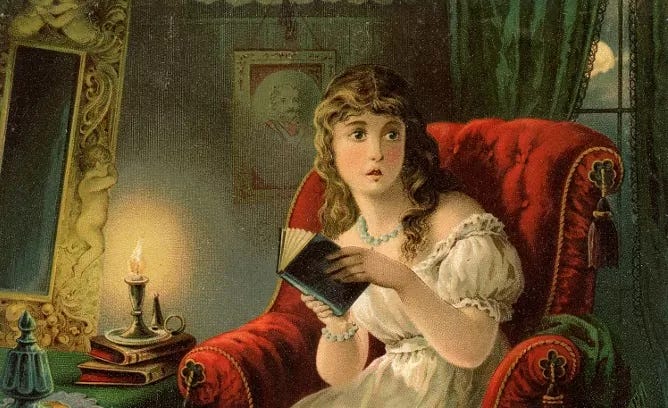Spooky season is fast approaching! I’m hoping to have some special Gothic projects in the works for the autumn season, but we’ll see how that pans out (no promises!). In the meantime, check out the past editions of the Grotto to get in the spooky spirit.
Is It Bad or Was It Written By a Woman?
As much as we place importance on “The Classics” in British literature, novels were not considered ~literary~ when they first began to gain prominence in the 1700s; it was commercial, lowbrow, and for the general public (not unlike how we currently view some reality TV). And of course, if you were a woman trying to write during this time, there was an additional barrier preventing your work from being taken seriously (aka the entire premise behind Virginia Woolf’s A Room of One’s Own).
Similarly, when the Gothic genre surfaced, it was viewed as trashy and immoral despite its widespread popularity. (Hmm, social criticism being called immoral by the group trying to enforce harmful standards — where have I heard that before?) The genre was also made popular by women, both by the writers (Ann Radcliffe and Mary Shelley) and by the readers, making it no surprise that the genre was met with harsh criticism. Even Minerva Press, who published several Gothic novels that were written by women, earned the same reputation of being lowbrow for its association.

The Female Gothic
In an attempt to draw attention to the contributions of women to the genre, the concept of the Female Gothic in the late 1970s. In short, the Female Gothic represents novels that focus on themes like domestic isolation, threat of sexual violence, and monstrous/absent mothers. While these themes certainly do exist in some Gothic novels, there is no clear cut distinction of who was writing in the “female” versus “male” style of the Gothic (For example, Frankenstein is considered to be Male Gothic.), and men and women were both reading Gothic novels.
Essentially, the Female Gothic (as often happens with the gender binary) shoehorns the themes of domesticity, sexual violence, and bad parenting into the realm of womanhood when in reality these are themes that we all can experience. At the same time, the Female Gothic also limits contributions made by women in the “male” style (Plus, are you really going to sit there and say that Victor Frankenstein doesn’t fall in the monstrous/absent parent category?).
The classification has also trickled into the modern versions of the Gothic. Shirley Jackson’s writing could fall into the Female Gothic because her fiction is so rooted in the experiences of domestic life and the housewife. Those are experiences traditionally reserved for “female” readers, but calling Jackson’s writing Female Gothic feels a little bit like calling her a woman writer. The Gothic criticizes society, morality, and humanity so there isn’t really a need to section off the themes that make up the Female Gothic into its own separate subgenre.
Queering the Lowbrow
While it is important to reflect on the history and contributions of women writing in the Gothic, it’s also necessary to acknowledge that the binary categories that have been applied to the genre no longer serve us (if they ever did). The Gothic has always been used to subvert, and we’re already seeing the genre being used to disrupt gender expectations through books like The Uncanny Case of Gilles/Jeannette by Jill Dearman and Unspeakable: A Queer Gothic Anthology edited by Celine Frohn. And if you see novels that continue to subvert and criticize being labeled as “unserious” or “sensationalist,” or even “immoral,” pay attention to who is calling it that and what they are actually saying about the novel.



